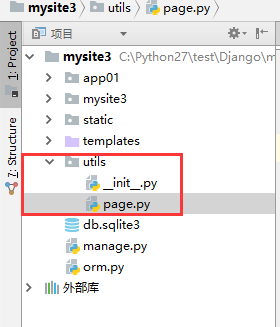这篇文章主要介绍了Python Django 封装分页成通用的模块详解,文中通过示例代码介绍的非常详细,对大家的学习或者工作具有一定的参考学习价值,需要的朋友可以参考下
新建 utils 文件夹,并创建 page.py

page.py:
class ShowPage(object):
def __init__(self, page_num, total_count, url_prefix, per_page=10, max_page=11):
'''
:param page_num: 当前页码数
:param total_count: 数据总数
:param url_prefix: a 标签 href 的前缀
:param per_page: 每页展示的数据数
:param max_page: 页面上最多显示的页码数
'''
self.url_prefix = url_prefix
self.max_page = max_page
# 总共需要多少页码来显示
total_page, m = divmod(total_count, per_page)
# 如果还有数据
if m:
total_page += 1
self.total_page = total_page
try:
page_num = int(page_num)
# 如果输入的页码数超过了最大的页码数,默认返回最后一页
if page_num > self.total_page:
page_num = self.total_page
# 如果输入的页码数小于 1,则返回第一页
if page_num < 1:
page_num = 1
except Exception as e:
# 当输入的页码不是正经数字的时候 默认返回第一页的数据
page_num = 1
self.page_num = page_num
# 定义两个变量保存数据从哪儿取到哪儿
self.data_start = (self.page_num - 1) * 10
self.data_end = self.page_num * 10
# 页面上总共展示多少页码
if self.total_page < self.max_page:
self.max_page = self.total_page
half_max_page = self.max_page // 2
# 页面上展示的页码的开始页
page_start = self.page_num - half_max_page
# 页面上展示的页码的结束页
page_end = self.page_num + half_max_page
# 如果当前页减一半比 1 还小
if page_start <= 1:
page_start = 1
page_end = self.max_page
# 如果当前页加一半比总页码还大
if page_end >= self.total_page:
page_end = self.total_page
page_start = self.total_page - self.max_page + 1
self.page_start = page_start
self.page_end = page_end
@property
def start(self):
return self.data_start
@property
def end(self):
return self.data_end
def page_html(self):
# 拼接 html 的分页代码
html_list = []
# 添加首页按钮
html_list.append('<li><a href="{}?page=1" rel="external nofollow" >首页</a></li>'.format( self.url_prefix))
# 如果是第一页,就没有上一页
if self.page_num <= 1:
html_list.append('<li class="disabled"><a href="#" rel="external nofollow" rel="external nofollow" ><span aria-hidden="true">«</span></a></li>'.format(self.page_num - 1))
else:
# 加一个上一页的标签
html_list.append('<li><a href="{}?page={}" rel="external nofollow" rel="external nofollow" rel="external nofollow" ><span aria-hidden="true">«</span></a></li>'.format(self.url_prefix, self.page_num-1))
# 展示的页码
for i in range(self.page_start, self.page_end + 1):
# 给当前页添加 active
if i == self.page_num:
tmp = '<li class="active"><a href="{0}?page={1}" rel="external nofollow" rel="external nofollow" >{1}</a></li>'.format(self.url_prefix, i)
else:
tmp = '<li><a href="{0}?page={1}" rel="external nofollow" rel="external nofollow" >{1}</a></li>'.format(self.url_prefix, i)
html_list.append(tmp)
# 如果是最后一页,就没有下一页
if self.page_num >= self.total_page:
html_list.append('<li class="disabled"><a href="#" rel="external nofollow" rel="external nofollow" ><span aria-hidden="true">»</span></a></li>')
else:
html_list.append(
'<li><a href="{}?page={}" rel="external nofollow" rel="external nofollow" rel="external nofollow" ><span aria-hidden="true">»</span></a></li>'.format(self.url_prefix, self.page_num + 1))
# 添加尾页按钮
html_list.append('<li><a href="{}?page={}" rel="external nofollow" rel="external nofollow" rel="external nofollow" >尾页</a></li>'.format(self.url_prefix, self.total_page))
page_html = "".join(html_list) # 拼接 html 的分页代码
return page_html
views.py:
from django.shortcuts import render
from app01 import models
def book_list(request):
# 从URL取参数
page_num = request.GET.get("page")
print(page_num, type(page_num))
# 书籍总数
total_count = models.Book.objects.all().count()
# 导入显示页码的函数
from utils.page import ShowPage
page_obj = ShowPage(page_num, total_count, per_page=10, url_prefix="/book_list/", max_page=11, )
ret = models.Book.objects.all()[page_obj.start:page_obj.end]
print(ret)
page_html = page_obj.page_html()
return render(request, "book_list.html", {"books": ret, "page_html": page_html})
book_list.html:
<!DOCTYPE html>
<html lang="en">
<head>
<meta charset="UTF-8">
<title>书籍列表</title>
<link rel="stylesheet" href="/static/bootstrap/css/bootstrap.min.css" rel="external nofollow" >
</head>
<body>
<div class="container">
<table class="table table-bordered">
<thead>
<tr>
<th>序号</th>
<th>id</th>
<th>书名</th>
</tr>
</thead>
<tbody>
{% for book in books %}
<tr>
<td>{{ forloop.counter }}</td>
<td>{{ book.id }}</td>
<td>{{ book.title }}</td>
</tr>
{% endfor %}
</tbody>
</table>
<nav aria-label="Page navigation">
<ul class="pagination">
<li>
{{ page_html|safe }}
</li>
</ul>
</nav>
</div>
</body>
</html>
以上就是本文的全部内容,希望对大家的学习有所帮助,也希望大家多多支持亿速云。
免责声明:本站发布的内容(图片、视频和文字)以原创、转载和分享为主,文章观点不代表本网站立场,如果涉及侵权请联系站长邮箱:is@yisu.com进行举报,并提供相关证据,一经查实,将立刻删除涉嫌侵权内容。